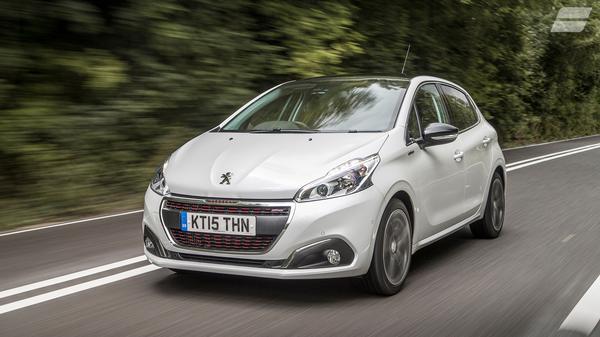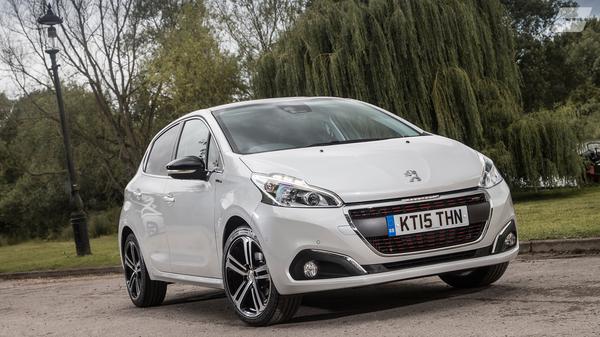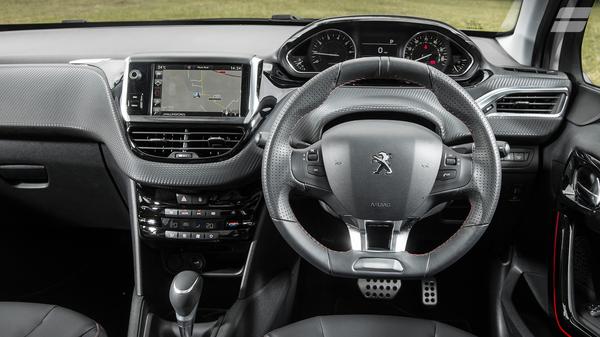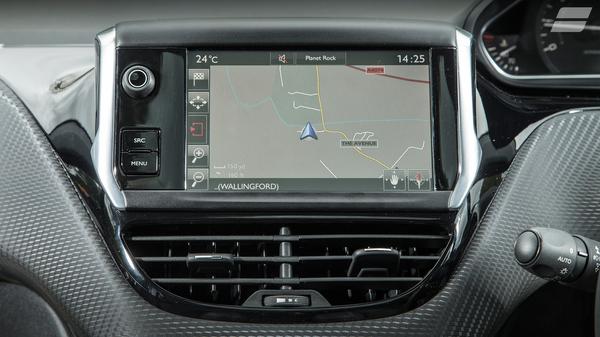Expert Review
Peugeot 208 Hatchback (2015 - ) review
Peugeot's 208 is a supermini with the accent on style that sets out to attract buyers away from the biggest-selling cars in the class, the Ford Fiesta and Vauxhall Corsa


Words by: Andy Pringle
Published on 31 July 2015 | 0 min read
The Auto Trader expert verdict:
2.8
The 208 has its plus points, especially the way it looks and the quality feel of the interior. However, it's way too compromised in too many other areas to trouble the class-leaders. If you're not totally sold on the 208's styling, we'd advise you to look elsewhere.
Reasons to buy:
- Looks good inside and out
- Wide choice of engines
- Good safety kit

How good does it look?
“The 208 has the sense of fun lacking in the Volkswagen Polo, and has easily as much style as the Ford Fiesta”
The designers of the 208 have tried to give the car a chic look, and we’d say they’ve succeeded. The range has a palette of 13 colours, so there’s plenty of choice, and not only does the 208 have the sense of fun lacking in the Volkswagen Polo, it also has easily as much style as the Ford Fiesta. The Peugeot’s body’s shape is neat and curvy, and the creases in the doors and bonnet give an even more sculpted look. The brake lights have three lines of LEDs in each cluster, mimicking a lion’s claw, and from Active trim upwards, the angular headlights are two-tone units, eyebrowed by LED daytime running lights. Only the most basic Access trim misses out on alloy wheels, while Allure models also get chrome door mirror shells; and, at the top of the range, GT Line and GTi models get a sporty makeover, complete with spoilers, chrome exhausts and extended wheelarches.
Expert rating: 4/5

What's the interior like?
“The 208’s interior represents a complete re-think of how things should be arranged, but it doesn't work”
The 208’s interior represents a complete re-think of how things should be arranged. The instruments are mounted high, while the smaller-than-usual steering wheel is mounted low, so you view the dials over the wheel rather than through it. It’s a bold idea, but unfortunately, it doesn’t work: many drivers, especially shorter ones, will find that the wheel obscures the dials, even when it’s set to an uncomfortably low position; and, taller drivers could find the wheel set too low, even in its highest position. Similarly disappointing is the touch-screen infotainment system that’s standard on all but the entry-level trim: the graphics are cluttered, and the way the various menus work is very confusing. It’s a shame, because the cabin actually looks very nice, with plenty of glossy panels and spangly trims. However, one or two of the more structural panels, such as the top of the dashboard, could be higher in quality.
Expert rating: 2/5
How practical is it?
Although space is fine up front, and rear legroom is quite good, practicality is another area in which the 208 disappoints. The rear headroom is too tight for adults to sit comfortably - especially in models that have the panoramic glass sunroof fitted - and, although the boot is generously sized and well-shaped, low-spec models miss out on the split-folding rear seats that allow you to extend the load area. That’s a bit mean. The Skoda Fabia, and Hyundai i20 are both much better in this regard.
Expert rating: 2/5

What's it like to drive?
“The jittery ride doesn’t translate into entertaining handling”
You may well be disappointed by the 208’s ride comfort. The suspension struggles to deal with too many lumps and bumps, especially at low speeds, so you’ll find yourself being jostled around in your seat. The jittery ride doesn’t translate into entertaining handling, either. There’s plenty of grip on offer, but the body leans over more than you’d think in bends. The steering could do with more feel, too, but it’s reasonably responsive and light around town, which helps with manoeuvring and parking. The 208 is small, too, which makes the 208 feel quick and darty, but in actual fact it's nowhere near as agile as the class-leading Fiesta. Likewise, compare the sportiest GTi versions with their Fiesta ST equivalents, and they don’t quite deliver the same level of engagement. That’s even true with the GTI By Peugeot Sport version, despite its even lower suspension and added differential.
Expert rating: 2/5
How powerful is it?
There’s a vast range of engine choices – petrol and diesel - for the 208. The petrols range from a 1.0-litre three-cylinder with 67bhp to a fiery 205bhp 1.6 turbo in the GTI, while the diesel options are all 1.6-litre units, ranging from 74- to 118bhp. We’ve driven two of the smaller petrols, both three-cylinder 1.2-litre units with outputs of 81bhp and 108bhp. The latter we’ve tried with both the standard five-speed manual gearbox and the six-speed automatic, and neither is ideal. The auto is slow to react and gives less-than-smooth changes, while the manual has a loose, vague shifting action. It also has a very abrupt clutch pedal, so unless you get the amount of revs absolutely spot-on, you’ll either be spinning the front wheels or trying not to stall every time you pull away. It’s a shame because, while the three-cylinder engine is a little rortier than some rival units, it’s not too loud or rough for comfort. What’s more, no matter which power output you plump for, both give reasonably flexible in-gear performance. We’ve also had a shot in the GTI, and this version feels very rapid indeed. It pulls well from low down in the rev range, and feels progressively stronger as the needle climbs, so it really encourages you to push harder and harder.
Expert rating: 2/5
How much will it cost me?
Prices are reasonable compared with other mainstream superminis, and resale values are on a par, too. All the diesels return upwards of 78mpg, while the cleanest car in the range, the 1.6 BlueHDi diesel, can manage an official average of well over 90mpg. Of the petrols, the 1.2-litre PureTech engine is the star performer, averaging more than 67mpg when paired with the automatic gearbox. Only the sporty GTis fail to better 60mpg, and they still manage an impressive 52.3mpg average. However, insurance costs are nothing special, and Peugeot’s warranty package is nothing to write home about, either.
Expert rating: 3/5
How reliable is it?
Peugeot’s reliability record has been patchy in recent years, but it’s encouraging that the company is currently sitting in the top half of Warranty Direct’s manufacturer rankings. It’s also very reassuring to see that by far the majority of owners on our website give the previous version of the car full marks for reliability. The 208’s solid build quality should give you further confidence in how it’ll stand up to the rigours of everyday use, although one or two of the plastic panels inside look like they’ll mark rather too easily. Similarly, the electrics, touch-screen and windscreen washers are known to be troublesome.
Expert rating: 3/5
How safe is it?
The basic safety package is standard across the range, meaning every 208 has six airbags to protect the driver and front passenger: two front, two side and two curtain ‘bags. The curtain ‘bags also offer protection to those in the back seats. There are two Isofix installations with three-point attachments in the rear, as well as tyre-pressure sensors, anti-lock brakes and electronic stability control. It all proved effective in Euro NCAP crash tests, in which the 208 (albeit the previous version to this car) scored the maximum five stars. The most significant safety-related option is the attractively priced Active City Brake system (available on all but Access trim), which can help to avoid or reduce the seriousness of an accident at speeds of up to 20mph, if the driver fails to react.
Expert rating: 4/5

How much equipment do I get?
“Active trim is our favourite, as it adds a touch-screen, DAB radio, alloy wheels, front foglamps and a split-folding rear bench”
Entry-level Access A/C trim comes with air-con, cruise control, electric front windows, remote central locking and Bluetooth. However, the next step up, Active trim, is our favourite, as it adds a touch-screen, DAB radio, alloy wheels, front foglamps and split-folding rear bench. Beyond that, Allure trim adds goodies like rear parking sensors, and automatic lights and wipers, while GT Line cars get climate control, sports seats and aluminium trim inside. At the top of the range, there are three versions of the GTI and all have a bespoke look, with the GTi Prestige getting sat-nav and heated seats, and the GTi by Peugeot Sport adding Alcantara seats, as well as its own sports suspension and styling package.
Expert rating: 3/5
Why buy?
Basically, because you like the way it looks. Other than that, we can’t see much of a reason to recommend the 208. Countless rival superminis offer you more talent for similar or less money. We’d stick with one of those.
Expert rating: 3/5